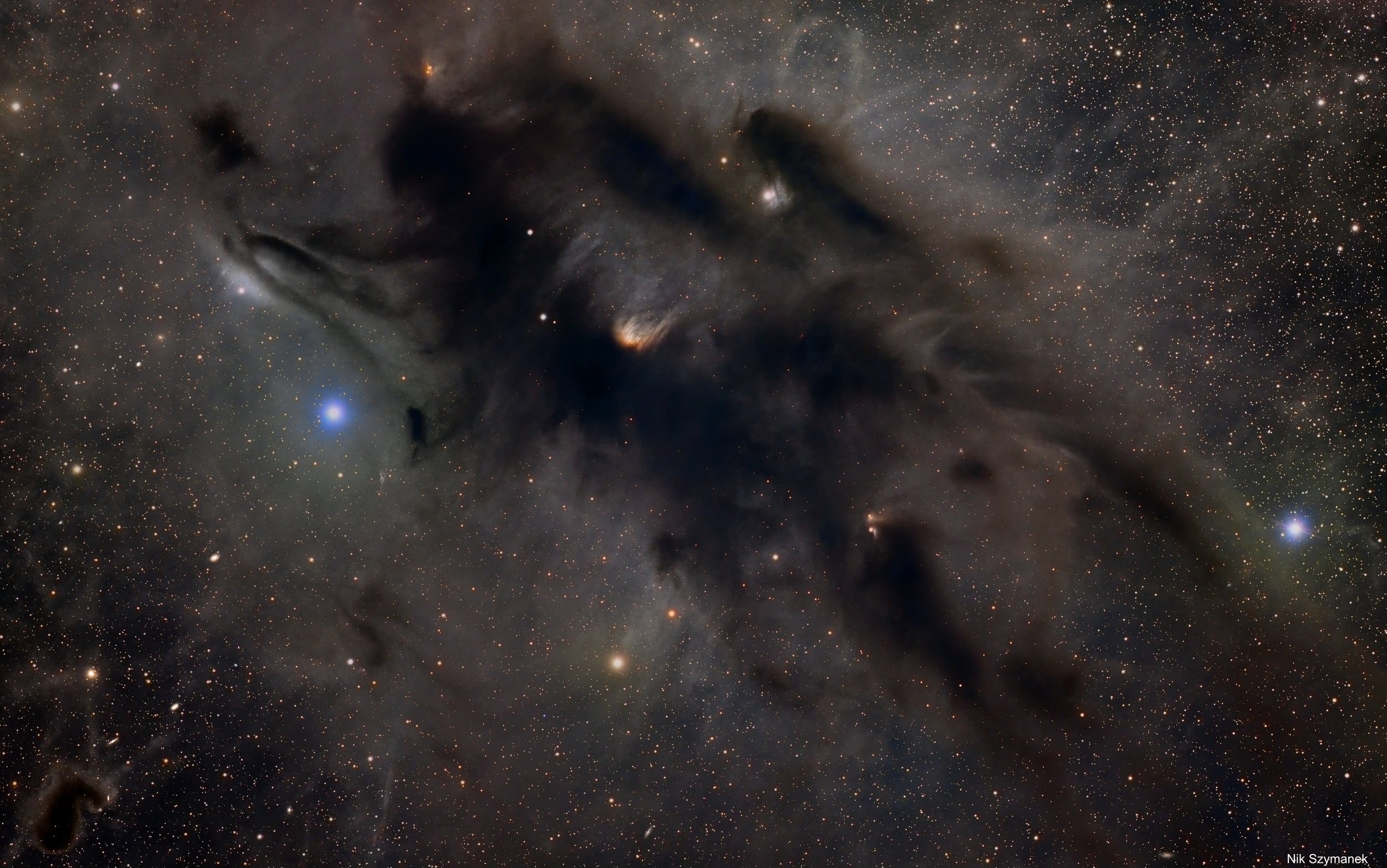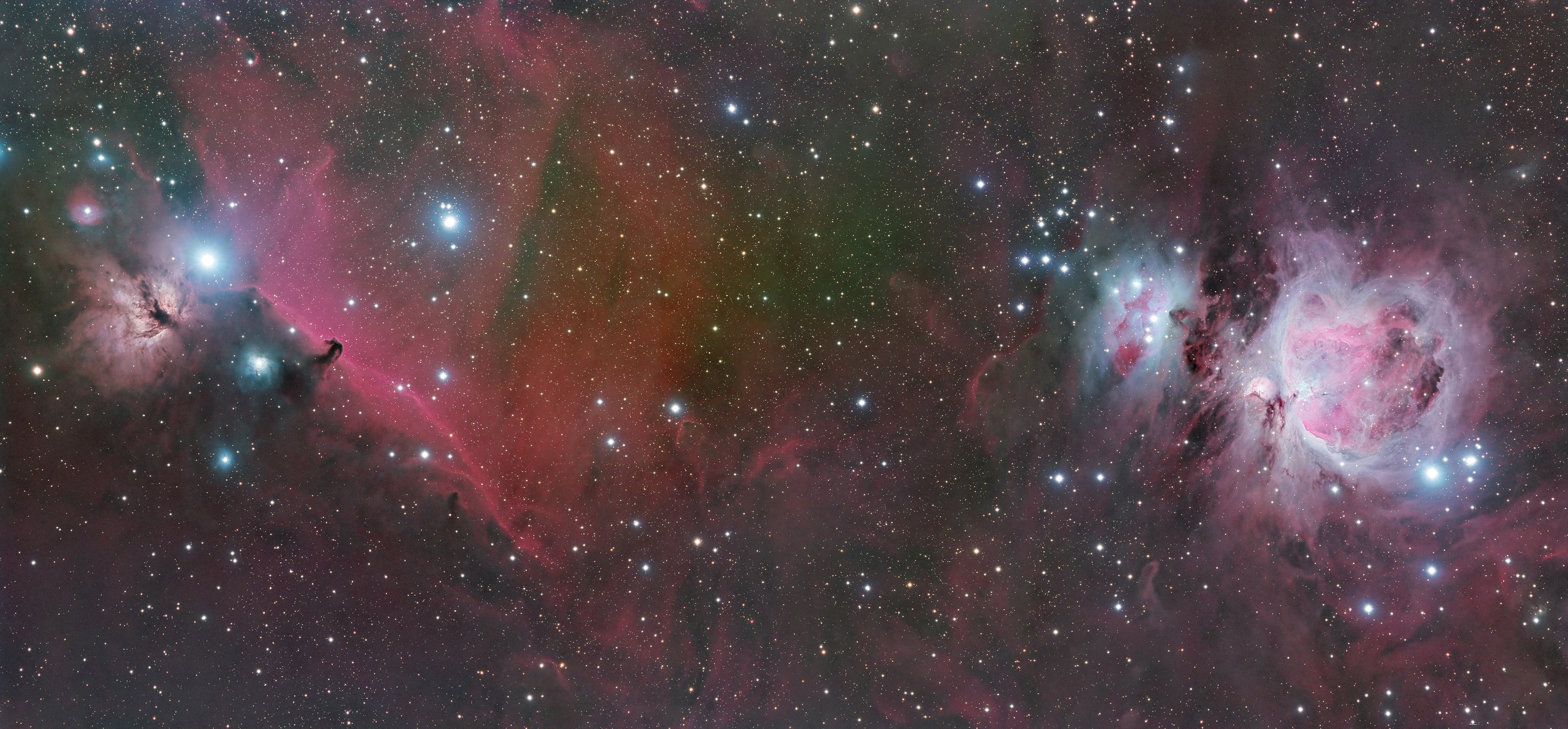
AAPOD2 Image Archives
NGC 1491 and PN Ou1
Nestled within the constellation of Perseus, NGC 1491 emerges as a celestial masterpiece, showcasing the intricate beauty of stellar birth and evolution. This emission nebula, illuminated by the energetic radiation of newborn stars, paints a vibrant portrait against the backdrop of the cosmic expanse.
At the heart of NGC 1491 lies a stellar nursery, where dense clouds of gas and dust collapse under their own gravity, giving birth to new generations of stars. The intense ultraviolet radiation emitted by these young stars ionizes the surrounding gas, causing it to glow with ethereal hues of red and blue. NGC 1491 serves as a stellar crucible, where the forces of creation sculpt the cosmic landscape, offering astronomers a window into the dynamic processes shaping our galaxy.
PNOU1: Exploring the Cosmic Mysteries in the Veil Nebula
PNOU1, nestled within the intricate filaments of the Veil Nebula, presents a fascinating glimpse into the aftermath of stellar death. This planetary nebula, born from the remnants of a dying star, showcases the intricate dance of gas and dust as it expands into the surrounding interstellar medium.
As the outer layers of the progenitor star are expelled into space, they form a luminous shell of ionized gas, illuminated by the fading light of the central remnant. PNOU1 represents a fleeting cosmic moment, a testament to the life cycle of stars and the transformative power of stellar winds and supernova explosions. Studying PNOU1 provides astronomers with valuable insights into the final stages of stellar evolution and the complex dynamics of interstellar matter, enriching our understanding of the cosmic tapestry woven across the vastness of space.
IC 2087 and Taurus Molecular Cloud
IC 2087 stands as a shadowy sentinel amidst the celestial expanse, a dark nebula shrouded in mystery and intrigue. Located within the boundaries of the constellation Taurus, this enigmatic cosmic cloud serves as a cosmic veil, obscuring the light of distant stars and revealing the intricate interplay of cosmic dust and gas.
As a dark nebula, IC 2087 offers astronomers a unique opportunity to study the processes of star formation and the dynamics of interstellar matter. Within its dense folds of dust and gas, new stars may be slowly emerging, their faint light struggling to pierce the veil of darkness. While its secrets remain largely hidden from view, IC 2087 beckons the curious gaze of astronomers, inviting them to unravel the mysteries of cosmic evolution and the birth of stars within the vastness of the cosmos.
Not Your Father's M39
Nestled within the constellation of Cygnus, M39 emerges as a stellar oasis amidst the celestial expanse, offering a captivating glimpse into the beauty and diversity of the cosmos. Comprising a collection of approximately 30 to 40 stars, this open star cluster presents a dazzling array of stellar luminosity against the dark backdrop of space.
At a distance of about 800 light-years from Earth, M39 serves as a stellar laboratory for astronomers, providing valuable insights into the formation and evolution of stars within our Milky Way galaxy. Its relatively young age of around 300 million years adds to its scientific allure, as researchers study the intricate dynamics of stellar birth and development within this celestial gathering. As observers peer into the heart of M39, they are invited to contemplate the vastness of the cosmos and the countless wonders that await exploration beyond the confines of our terrestrial realm.
Barnard's Merope IC349, inside Merope NGC1435 in the Pleiades
Amidst the cosmic tapestry of the Pleiades star cluster, the ethereal beauty of Barnard's Merope, designated IC 349, unfolds as a delicate nebular veil draped around the celestial jewel Merope. This intricate scene captures the interplay of interstellar dust and starlight, creating a celestial spectacle that graces the Pleiades with a touch of cosmic elegance.
IC 349, a reflection nebula, mirrors the radiant glow of Merope, one of the Seven Sisters within the Pleiades cluster. The nebular veils, illuminated by the star's brilliance, add a subtle celestial adornment, enhancing the visual richness of this stellar ensemble. As astronomers gaze upon Barnard's Merope, they witness not only the aesthetic charm of interstellar dust but also the scientific significance embedded in the delicate dance between starlight and cosmic particles. This cosmic tableau serves as a testament to the intricate relationships within star clusters, offering a glimpse into the astrophysical processes that shape and adorn our celestial surroundings.
Loop prominence
In the dynamic theater of the solar atmosphere, a captivating image captures the intricate dance of a solar loop prominence, adding a dramatic flair to the ever-changing canvas of our sun. This celestial ballet unfolds in the chromosphere, where magnetic forces sculpt vast arches of hot, ionized gas that leap and twirl against the solar disk.
This particular solar loop prominence, suspended by magnetic fields, manifests as a luminous arc reaching out from the sun's surface. The image not only showcases the aesthetic beauty of this solar feature but also provides a glimpse into the underlying astrophysical processes at play. As charged particles traverse magnetic highways, their graceful choreography is frozen in time, revealing the intricate dynamics that shape the sun's outer layers. Observing such solar phenomena not only captivates the eye but also deepens our understanding of the sun's complex and ever-active nature, highlighting the delicate balance between gravitational forces and magnetic influences on our closest stellar neighbor.
Old dried trees and this amazing view of the Cygnus constellation
In the quiet solitude of ancient, gnarled trees, a celestial spectacle unfolds as the Cygnus constellation graces the night sky with its timeless elegance. Against the backdrop of old, dried branches, this captivating view presents a harmonious blend of natural elements and cosmic beauty.
The Cygnus constellation, marked by the distinctive Northern Cross asterism, becomes a celestial companion to the weathered trees, casting its stellar glow amidst the earthly silhouette. The juxtaposition of the timeless landscape and the cosmic ballet above creates a scene that transcends epochs, inviting observers to marvel at the enduring interplay between the terrestrial and the celestial. As stargazers absorb the ethereal ambiance of this scene, they are reminded of the profound connection between the ancient narratives etched in terrestrial landscapes and the enduring allure of the cosmic realms above.
NGC 1977: “Running Man” nebula
In the cosmic ballet of the Orion Molecular Cloud Complex, the Running Man Nebula, designated NGC 1977, emerges as a celestial masterpiece that seamlessly blends elegance and dynamism. This intricate nebula, situated in the vicinity of the iconic Orion Nebula, captures the imagination with its wispy tendrils of gas and dust, resembling a celestial figure in perpetual motion.
As part of the larger Orion Complex, NGC 1977 is a reflection nebula illuminated by the luminosity of nearby stars. The interplay of stellar radiation with the surrounding cosmic medium results in the ethereal glow that characterizes this cosmic tapestry. In the cosmic theater, the Running Man Nebula invites observers to appreciate not only its aesthetic charm but also the astrophysical processes at play. As astronomers delve into the scientific intricacies of NGC 1977, they uncover insights into the complex dynamics of star formation and the interstellar environment, turning this celestial portrait into a gateway for both artistic appreciation and scientific exploration in the expansive canvas of the cosmos.
The sword of Orion in a 3 panel mosaic
In the celestial tapestry of Orion, the Sword of Orion unfolds in a captivating 3-panel mosaic, featuring the iconic Orion Nebula (M42), the Flame Nebula (NGC 2024), and the Horsehead Nebula (Barnard 33). The Orion Nebula (M42) takes center stage, a stellar nursery aglow with the radiant energy of young stars. Adjacent, the Flame Nebula (NGC 2024) adds its fiery glow, showcasing the dynamic interplay between stellar radiation and the surrounding cosmic medium. Completing the trio, the enigmatic Horsehead Nebula (Barnard 33) casts its shadow against the Orion Molecular Cloud Complex, a dark silhouette sculpted by cosmic forces. As observers delve into this 2-panel mosaic, they embark on a visual journey seamlessly intertwining the artistic allure of nebular landscapes with the scientific exploration of stellar birth and cosmic evolution.
This celestial diptych not only captivates the eye but also beckons the curious mind to explore the astrophysical intricacies embedded in the heart of Orion. As astronomers and stargazers navigate the cosmic expanse, the Sword of Orion stands as a testament to the harmonious convergence of artistic beauty and scientific inquiry in the realm of stellar landscapes.
M106
In the astronomical tapestry of Canes Venatici, M106 emerges as a captivating spiral galaxy, beckoning the gaze of astronomers and stargazers alike. This celestial beauty, also known as NGC 4258, unveils its intricate spiral arms and luminous core in a display of cosmic grandeur. M106 belongs to the relatively nearby M94 Group of galaxies, adding to the cosmic richness of this corner of the universe.
Situated approximately 23.5 million light-years away, M106 offers a unique opportunity for scientific exploration. Astronomers have probed its core, discovering a supermassive black hole that fuels powerful jets emanating from the galactic center. The interplay of gravitational forces and cosmic phenomena within M106 provides a canvas for unraveling the mysteries of galactic dynamics and the profound influence of supermassive black holes on their cosmic surroundings. As observers peer into the depths of Canes Venatici, M106 stands as a celestial testament, blending artistic beauty with scientific inquiry in the realm of spiral galaxies.









